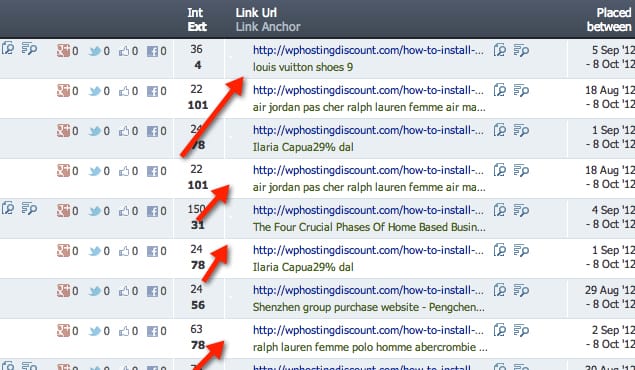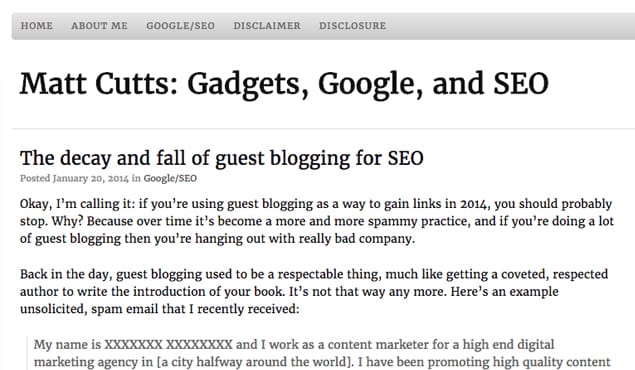The world of blogs is one rife with posts, guest posts, product reviews, and authors working with manufacturers to create consumable content for readers.
You’re most likely a part of that mechanism, probably the author of said blog, posts, and guest posts, and you’re wondering about this whole “Dofollow” and “Nofollow” topic, of which you have just learned.
To get into the meat of this issue, and precisely what you should do it about, it’s important first to understand why it exists at all.
The History of Nofollow Links
Google is the main player in this world because, as you may know, Google is the presiding ruler of all things search.
When you search for information on the internet you often go to Google, type in a few words, and read through the first 10 or 20 results to get the answer you’re looking for.
That very simple outcome is a fiercely waged war behind the scenes, with companies, blogs, government websites, essentially any source of online information leading buckets of burning tar over the metaphorical walls in order to be placed first in Google’s search, and if not first, then at least top 10.
Humans are basically simple creatures, and simple creatures only click through those first results.
Backing up even further, it’s also important to know that the way Google became presiding ruler of all things search is through its original algorithm. This, at the basic level (I won’t get into the technical level), used the number of links pointing to a website to determine its relevancy and authority in a given subject.
It works like this: If websites all over the internet linked to National Geographic’s website 10,000 times, all of them in the fields of science, outdoors, and nature, Google’s algorithm would determine that National Geographic was an authoritative source on those things, and therefore it would come up in the first pages of search. This is opposed to a relatively un-linked-to website, like NatureRules.com (not a real thing), that is only linked to 100 times across the internet.
That was the original method, and still what Google is based upon today. Except, today, it’s much more complicated.
Link Spam and Abuse
Hopefully you’re a smart cookie and can see the inherent flaw with this system. If the only thing determining a site’s relevancy is other websites linking to it, what’s to stop people from linking to their own site incessantly, excessively, and all over the place?
Nothing is stopping them.
The rise of spam in this context (not the spam in your email inbox) comes in the form of comments on discussions of articles, dummy websites that contain endless hyperlinks (link farms), and poorly written articles that were created just to include specific keywords and hyperlinks.
All this to support the rise of certain websites in Google’s search rankings.
Clearly, something had to be done. Nobody wants the spammers to win.
The Introduction of Nofollow Links
The year was 2005, and the spammers had inundated the web so seriously that Google had to react. They created a special tag called the Nofollow tag.
It looks like this in code:
<a href=”http://www.website.com/” rel=”Nofollow”>Link Text</a>
Before this tag was released all hyperlinks were considered legitimate, and followed by Google’s crawlers. The Nofollow tag makes it so the crawlers still go through the hyperlink to the URL, but they do not carry any of the information over to the way Google ranks pages.
Essentially, it’s a way for web developers to specify when a hyperlink should not be counted for Google’s search.
This is extremely helpful for certain sections of websites, like the comments, which can now be deemed Nofollow immediately, so any links posted there contain no weight.
While it effectively created a method for controlling spam, it still required the web developers or owners themselves to mark such hyperlinks as Nofollow. Google couldn’t do it by itself (that would be terrible), and it still can’t.
Hyperlinks in Guest Posts
Moving right along, we come to the storied tradition of guest posting. I’ll assume you have a pretty solid handle on this concept, as you’re on a site called Guestpost.com, reading about how useful it is to post (i.e., guest post) on sites that only allow Nofollow links.
A legitimate way to get more authority links is through guest posts. You can write 300 words on a topic, include a couple links back to your own site, and send it off.
Before 2014, this was a common and frequently used practice to build a new site’s ranking in Google search. Just imagine a content factory churning out 50 guest posts a day, hyperlinking their own sites across many other sites to grow in the ranks of Google search.
There were sites like MyBlogGuest that encouraged this practice, going so far as setting up guest posters with companies or organizations that would take guest posts, in exchange for Dofollow links (the opposite of Nofollow), thereby mutually growing brands and rank in Google.
There is always a double-sided coin when it comes to this topic — whether or not Dofollow links should be used in Guest Posts.
When done as a content farm factory and link factory, it’s clearly a manipulation of Google’s algorithm and does not, in any way, help readers.
When done legitimately, guest posts should absolutely include Dofollow links to relevant resources. If your website happens to be a relevant resource, by all means link to it.
Google’s Request
To combat this sort of Guest Post spam, Google’s former head of web spam, Matt Cutts, wrote a now-legendary post calling the practice out. In it he noted the issues I have laid out above, and talked about how Google was releasing future updates (like Penguin) to combat this practice.
Google also announced it would be punishing those who abused the system and, at the time, took MyBlogGuest and a few other high-profile guest post blogs completely out of its search. Talk about a punishment.
This has blown over in a number of ways since 2014. Guest posting still exist, people still spam some hyperlinks, but the growth of that industry has been curtailed.
Today, guest posting is more firmly rooted in the ideas of community building, concrete information and authorities collaborating. If you can squeeze in some Dofollow hyperlinks through the guest post, more power to you.
Despite all that, Google has made a specific request of all web masters, developers, and those running the content on websites that accept guest posts:
“Any links intended to manipulate PageRank or a site’s ranking in Google search results may be considered part of a link scheme and a violation of Google’s Webmaster Guidelines. This includes any behavior that manipulates links to your site or outgoing links from your site.”
Obviously, this is specifically about using Dofollow links in exchange for money, goods, or services. The last thing Google wants is to have its search methodology compromised by who can pay the highest price most often — that’s no way to catalogue good information.
For sites that do write posts, or receive guest posts, based on products or services offered by other companies, Google writes:
“Bloggers should use the Nofollow tag on all such links because these links didn’t come about organically (i.e., the links wouldn’t exist if the company hadn’t offered to provide a free good or service in exchange for a link). Companies, or the marketing firms they’re working with, can do their part by reminding bloggers to use Nofollow on these links.”
The search engine giant is pretty clear.
You, dear reader, could either be a guest poster, or someone receiving a guest post. Either way you need to consider the motivations of your writing, or the person writing, and if the links you’ve (or they have) included in your (or their) article are relevant to your readers, or in violation of Google’s terms.
You can receive a penalty for not following these rules. However, if you’re a relatively small blog, the likelihood of that happening is small.
Where Should You Post?
With the history out of the way, we get to the question of whether on not you should post on sites that only use Nofollow links.
This moves into you being an author, specifically a guest poster with their own blog, who has decided to expand to other publications.
You write these guest posts for many reasons:
- Byline exposure. You increase the scope of your name.
- Every time you write for a legitimate publication you increase your own authority on the topic.
- All those comments on your article are a good thing, and will trickle into more readers and subscribers on your own website. You can participate in this community as well as foster it.
- Connect with other experts in your niche. By guest posting you will make connections with the powerful players in your niche. If you write excellent articles for them you will be part of that inner circle, and benefit from being in it.
- Dofollow links back to your website.
Before I get into the specifics of No. 5, you’ll notice that 1-4 have nothing to do with Google’s search algorithms or getting your website a better rank. They have to do with growing your brand, your authority, and your community.
These elements are what’s key to writing any content today — and really, that’s always been true.
Yes, it’s incredibly useful if you come up in the top five searches on Google, but that will come with time. You can grow in so many ways, and guest posting on a site does that regardless of a Nofollow or Dofollow link.
That said, I do want to discuss No. 5 more specifically. In today’s world it’s pretty common for every guest post to come with a Dofollow link back to your website. This is typically found in the author byline, and is just a single link to your website.
There’s no way Google can penalize for this, because the context is that you are the author of said blog, and readers will find it relevant to be able to visit that blog. There is no cheating of the system in this method. However, there are still websites that refuse to include a Dofollow link, even if it’s to your website in the author byline.
The question of if it’s still useful to post on a site that has Nofollow links can be split in a number of ways, but the answer is, ultimately, “yes”.
All Nofollow Links
As I’ve said, there are incredibly strict websites that will never, ever, allow a Dofollow link on an guest post you write.
The reason for this is that these sites don’t want to upset Google at all. They are typically monstrous sites with plenty of link juice, and don’t pass on link juice to others ever, or if they do it’s very rare and very specific, and will never come from a guest post author.
In this case, yes, it’s absolutely worth writing for these sites.
Why? They are huge sites, and writing for them will boost your author profile (even if there are no links). You can put such sites in your rolodex, your resume, your portfolio, and hopefully establish a lasting relationship with them.
The fact that you don’t get a Dofollow link back your site is secondary.
To complicate this a bit, I do recommend getting paid for such a guest post, because these larger organizations typically have the dough.
Select Dofollow Links
This is the category most websites — big or large, blog or corporate — will fall under. When you write a guest post there is always the underlying assumption you’ll get one Dofollow link back to your website via the author byline.
It is perfectly acceptable for you to ask about this, and most of the time they’ll say yes.
The place that is up to the blog, and less clear, is whether or not they will Nofollow the links you include in the prose of the article.
I’ve received a number of guest posts that include links to websites that sell stuff. Yes, these websites sell stuff that are relevant to the article, but they’re not very relevant. The author of the guest post doesn’t explicitly say why they are there, so the links are suspect.
Usually I take those links out altogether. They don’t need to be there. However, if they are helpful, but still may include some juice that I’m not aware of, my next course of action is to Nofollow the link.
This keeps it visible and relevant for readers, but lets Google know that I am not condoning the link in terms of search rank.
In that scenario I also typically ask the author why that link was there — so, if you’re a guest poster, be prepared to answer why you included certain links.
The best links to include for most guest posters are those that are highly relevant to the topic at hand. Typically that doesn’t mean a service or product, but another article that explains a complex process.
You want to link to articles that provide information, not stuff one can buy. This assures the people you’re writing for that you care about their readers, and have no stake in what gets a Dofollow or Nofollow link.
If an article on your blog happens to be relevant you can include it, but put a note to the editor that you’ve done so and explain why. They may take it out, or they may Nofollow it. It’s their prerogative.
All Dofollow Links
The last scenario is a site that explicitly says, from the get go, that all links you include will be Dofollow links.
You actually want to steer clear of these sites. They are essentially saying that they will exchange a free guest post for a Dofollow link, which is precisely what Google’s guidelines say not to do.
Yes, you will get a link, but at what cost?
Nofollow For the Win
Nofollow gets a bad rap in the guest post world.
From my perspective, it’s not all that terrible, its actually a necessity. Sure, Google’s algorithms won’t include the links in the algorithms for search rank, but you should be writing an article that stands on its own. That way, when somebody links back to your article, it will likely be with a Dofollow link, and you’ll get search rank that way.
Nofollow still allows readers to visit the site, which will increase traffic. It has nothing to do with building a community or authority in a niche, which are more important than search rank.
It’s important to know if a site uses Nofollows or Dofollows, but it should never dictate where you write.
 ContentPowered.com
ContentPowered.com








